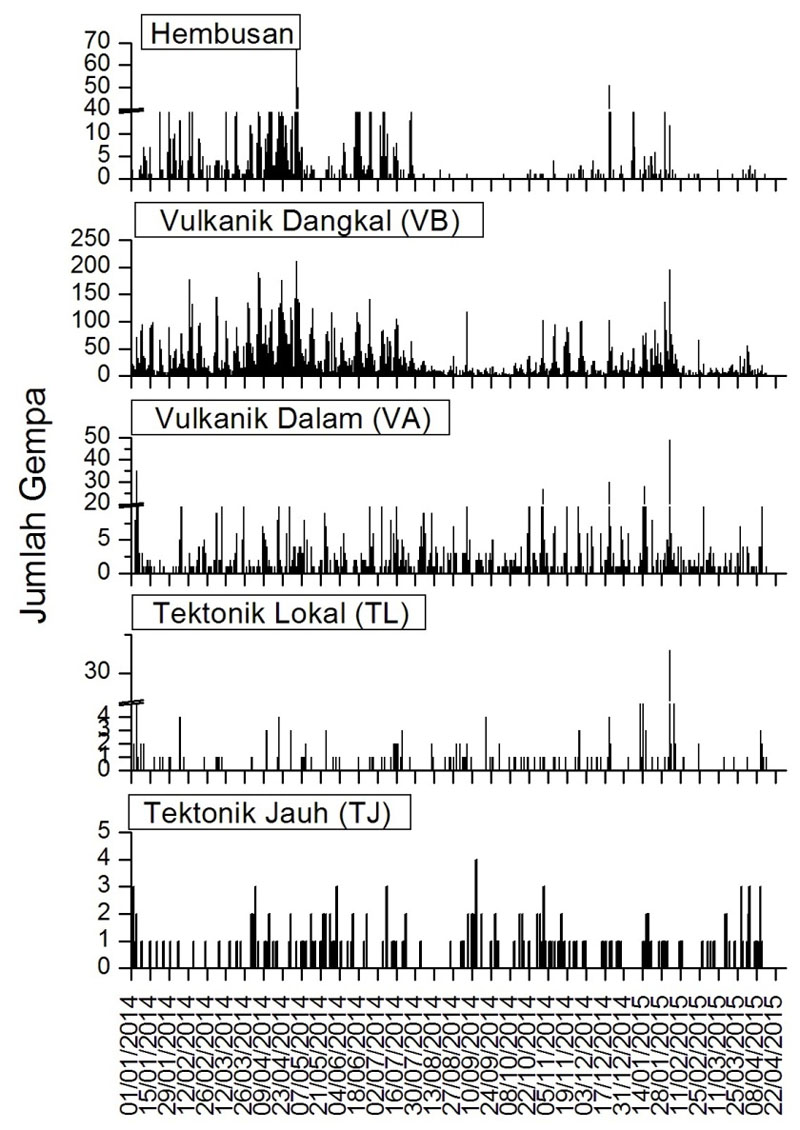Report on Krakatau (Indonesia) — August 2015
Bulletin of the Global Volcanism Network, vol. 40, no. 8 (August 2015)
Managing Editor: Edward Venzke.
Research and preparation by Jackie Gluck.
Krakatau (Indonesia) Diffuse white plumes to 25-50 m; shallow and deep volcanic earthquakes in 2014-15
Please cite this report as:
Global Volcanism Program, 2015. Report on Krakatau (Indonesia) (Venzke, E., ed.). Bulletin of the Global Volcanism Network, 40:8. Smithsonian Institution. https://doi.org/10.5479/si.GVP.BGVN201508-262000
Krakatau
Indonesia
6.1009°S, 105.4233°E; summit elev. 285 m
All times are local (unless otherwise noted)
Eruptive activity at Anak Krakatau has been intermittent in recent years, with variable activity during March-September 2009 (BGVN 34:11), October 2010-March 2011 (BGVN 36:08), and July 2011-September 2012 (BGVN 37:11 and 37:12). Volcanic earthquakes and seismicity related to fumarolic emissions has been reported between January 2014 and July 2015, but the only eruption during that time was an ash plume seen by a pilot on 31 March 2014.
The Indonesian Center of Volcanology and Geological Hazard Mitigation, Pusat Vulkanologi dan Mitigasi Bencana Geologi (PVMBG), reported that during January-25 May 2014 diffuse white plumes rose 25-50 m above Anak Krakatau. Seismicity continued to be dominated by shallow and deep volcanic earthquakes, as well as signals indicating emissions. Based on a pilot observation, the Darwin Volcanic Ash Advisory Centre (VAAC) reported that on 31 March 2014 an ash plume from Anak Krakatau rose to an altitude of 3 km and drifted N. Ash was not identified in satellite images.
During 1 March-12 July 2015 PVMBG again noted diffuse white plumes 25-50 m above Anak Krakatau, although foggy weather often prevented observations. Seismicity, which was high through at least 11 August, continued to be dominated by shallow and deep volcanic earthquakes, as well as signals indicating emissions (figure 35).
Geological Summary. The renowned Krakatau (frequently mis-named as Krakatoa) volcano lies in the Sunda Strait between Java and Sumatra. Collapse of an older edifice, perhaps in 416 or 535 CE, formed a 7-km-wide caldera. Remnants of that volcano are preserved in Verlaten and Lang Islands; subsequently the Rakata, Danan, and Perbuwatan cones were formed, coalescing to create the pre-1883 Krakatau Island. Caldera collapse during the catastrophic 1883 eruption destroyed Danan and Perbuwatan, and left only a remnant of Rakata. This eruption caused more than 36,000 fatalities, most as a result of tsunamis that swept the adjacent coastlines of Sumatra and Java. Pyroclastic surges traveled 40 km across the Sunda Strait and reached the Sumatra coast. After a quiescence of less than a half century, the post-collapse cone of Anak Krakatau (Child of Krakatau) was constructed within the 1883 caldera at a point between the former Danan and Perbuwatan cones. Anak Krakatau has been the site of frequent eruptions since 1927.
Information Contacts: Darwin Volcanic Ash Advisory Centre (VAAC), Bureau of Meteorology, Northern Territory Regional Office, PO Box 40050, Casuarina, NT 0811, Australia (URL: http://www.bom.gov.au/info/vaac/); Indonesian Center of Volcanology and Geological Hazard Mitigation, Pusat Vulkanologi dan Mitigasi Bencana Geologi (PVMBG, also known as CVGHM), Jalan Diponegoro 57, Bandung 40122, Indonesia (URL: http://www.vsi.esdm.go.id/).


